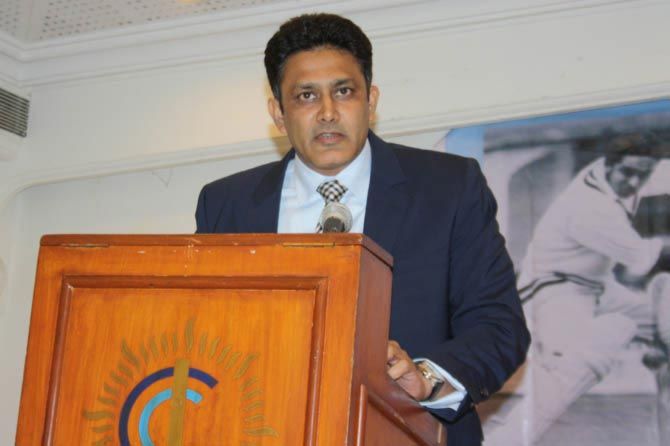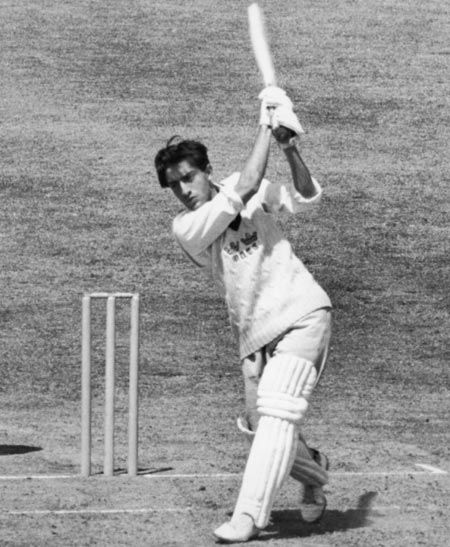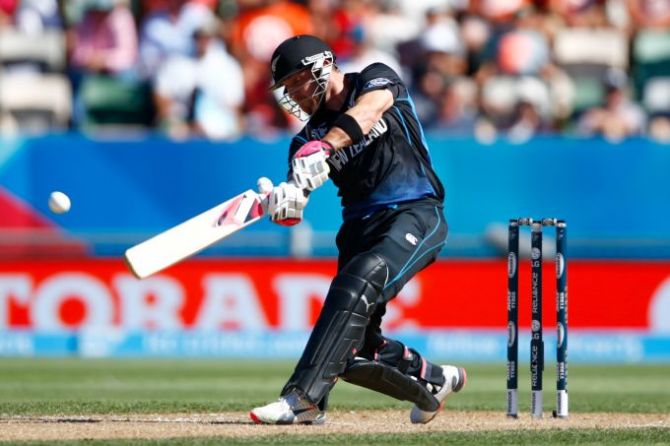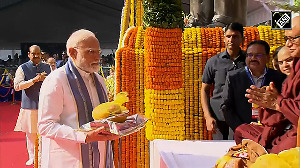'Of the 32 captains who have led India in Test cricket, only four have been pure bowlers -- Ghulam Ahmed, Venkatraghavan, Bishan Bedi and myself.'
'The captain must lead with only one idea in mind -- to win the game. The draw mentality is partly because captains lacked confidence and partly because they want to protect their record. If you don't think winning is the point of the game, there is little point in even entering the field.'
'As the Monkeygate controversy raged, I received a message from Bishen Bedi, no stranger to controversies himself. "As a captain," he wrote, "take a decision you will be proud of when you look back on history".'
Anil Kumble, cricketing legend, on the Art of Captaincy.
Delivering the seventh Dilip Sardesai Memorial Lecture at the Cricket Club of India's C K Nayudu Hall in Mumbai on Saturday, October 3, spin great Anil Kumble spoke about captaincy, his experience of leading the Indian team and why some of the greatest players like Gary Sobers and Ian Botham did not make good captains.

Mrs Nandini Sardesai, Rajdeep, members of the CCI, ladies and gentlemen,
It is a privilege to be asked to deliver the Dilip Sardesai Memorial Lecture after many illustrious names who have spoken in the past, all have been former India captains.
My most memorable meeting with Mr Sardesai was on the Air-India flight bringing the Indian team, some former players, the Indian fans and the media back home from South Africa after the 2003 World Cup.
India had made it to the final, but I had been dropped. Mr Sardesai was shocked that I hadn't played. 'There were reasons other than cricket for you not playing the final,' he told me.
When I told him this wasn't necessarily true, he became insistent. He became so upset at what he saw as an injustice, that for the sake of peace I finally agreed with his theory. I was touched at his concern. I have great respect for former players who feel strongly for current ones.
By then Rajdeep had become a good friend, I say that although sportsmen don't like admitting that they have good friends in the media, but still, it was the name 'Sardesai' that made it easier.
After claiming my 10 wickets in an innings against Pakistan, it was to Rajdeep that I spoke to exclusively in the studio. Again, it was the 'Sardesai' name that swung it for me.

When Rajdeep and Nandini Sardesai invited me to talk, I asked what topic should I talk about. Rajdeep said why don't you talk about spin bowling and how we need to revive spin bowling in India. I thought to myself whether I actually qualify because I think the debate about whether I played for India as a spin bowler or a fast bowler I don't think it has been ever resolved so I don't even want to indulge in trying to resolve that.
So I thought let me talk about captaincy.
The late Dilip Sardesai never led India, but he was a pillar of support to those who did. We will come to that aspect of captaincy in a while.
When Sourav Ganguly was captain, he said that the job was the second most important in the country. The editor of The Times of India had earlier said that his was the second most important job in the country. I don't think the matter is also ever resolved, and I am not aware if anybody else -- be it the local postman or the person entrusted with keeping the corridors of our Parliament clean -- thought he had the second most important job.
It doesn't really matter. Let us accept that captaining India is an important job. And look at what it entails.
A former English cricketer defined the captain thus: A public relations officer, an agricultural consultant, a psychiatrist, an accountant, a nursemaid and a diplomat. To that list, I would also like to add: A policeman, a mathematician, a computer analyst, etc.
But let's first talk about the bias, not peculiar to India alone, against bowler-captains.
Of the 32 captains who have led India in Test cricket, only four have been pure bowlers -- Ghulam Ahmed, (Srinivas) Venkatraghavan, Bishan (Singh) Bedi and myself.
Of the 45 who have led Australia, only two were bowlers, one of them Ray Lindwall stepping in for only one Test. Ian Johnson led in 17 Test matches. Richie Benaud was a full-fledged allrounder by the time he led.

England have had only two bowler-captains among 79 -- Bob Willis and John Emburey. You could argue that we need to include Ray Illingworth, but might find it hard to justify the choice of a man with over 20,000 runs in first class cricket and two Test centuries.
It is a cliche to say that you need to take 20 wickets to win a Test and it is the bowlers who get you the 20 wickets.
It follows that the bowlers are, by and large, the thinking members of any eleven for they have to be constantly plotting and planning and strategising and looking for weaknesses in the opposition -- these are precisely the things that captains do. Yet, the bias exists.
However, there is some merit to this argument but not significant enough to keep the captaincy from a good thinker. In India, Erapalli Prasanna, Zaheer Khan and Javagal Srinath were all fine thinkers on the game, but were never in the running for the top post.
My great contemporary Shane Warne wasn't given a chance either, although the men who got the job relied on his tactical acumen and reading of the game.
Having got that out of the way: Let us look at captaincy in general and captaining India in particular.
The dada of them all, Mike Brearley, once said that a cricket eleven works only by a dint of differentiation unlike a rowing eight, or for that matter a tug-of-war team. The skills are diverse, the temperaments varied, the roles specifically laid out.
An Indian captain is a friend, guide, philosopher to the players under him. Madan Lal has said of playing under Bedi, 'He was not just the captain; he was a total guide to us, telling us how to eat, what to read and how to carry ourselves.'
The captain of India, besides dealing with these elements, has to handle another range -- language and cultural differences, varied expectations as well as technical variations depending on who coached the individuals.
There is, too, the job of explaining how a batsman with poor technique makes runs while another with fine technique struggles. You need to have the answers for each one of them.
Thanks to the communication explosion and the support staff available to the team, the friend-guide-philosopher role of the Indian captain has been reduced. Yet, Indian players prefer to have a leader they can look up to, someone whose judgements outside the field of play they can trust and follow blindly.
No talk on captaincy is complete without Richie Benaud's classic statement: 'Captaincy is 90% luck and 10% skill. But don't try it without that 10%.'
Graham Gooch once told reporters: 'A dynamic bowling change that you write about is probably sheer luck nine times out of ten.' There's that 90% again but that might be giving luck too much credit.
Captains realise over a period that if they plan right and understand the strengths and weaknesses of the opposition, luck attaches itself to their side.
The game is about maximising resources aimed at one goal -- WINNING. Some captains tend to go into the first Test of a series, especially away from home, playing for a draw.

The captain must lead with only one idea in mind -- to win the game. The draw mentality is partly because captains lacked confidence and partly because they want to protect their record.
I have always felt it is better to lose in pursuit of victory than to kill a game with defensive tactics.
If you don't think winning is the point of the game, there is little point in even entering the field.
Planning, these days, is handled by a committee of coaches, team director, computer analyst, and, of course, the captain.
The team meeting is now an established part of pre-match rituals. Often the younger players are diffident and hesitate to express an opinion. It is the captain's job to draw them out and give them confidence to speak and make them feel part of the team. This is not just an exercise in team building, but important tactically too.
Youngsters do not carry the baggage of some of the seniors who might have played through terrible defeats or have entrenched views on players and tactics. Youngsters can stir things up.
Confidence, in fact, is the name of the game. By the time a player graduates to the international level, his game is usually settled. The difference between two similar talents is often one of confidence. The team takes its cue from the captain. Confidence, like the common cold, is catchy. Excellent teams can perform below par for lack of confidence, and vice versa.
Cricket is a dynamic sport. Conditions change from day to day, sometimes session to session, even hour to hour. This is one of the charms of the sport. The captain must be prepared.
I have read that on a wet track, once Don Bradman reversed his batting order to give the wicket time to settle down before his main batsmen took over.
It is good to have all the information -- weather, pitch conditions, recent scores, general behaviour of the track and lots more -- at your fingertips. Don't forget the opposition has the same information too.
Having got the right team and the necessary information, it is now up to the captain to work his tactics around them.
How often have we heard: 'Oh God! Look at what the selectors have given me!' That is a common refrain from most captains.
This is a far cry from the days when a Surrey captain is reported to have said, 'A captain can do nothing for his side other than win the toss.'
The captain who is struggling to keep his place in the side usually has an effect on the team. There are exceptions, of course.

Tiger Pataudi led India from 0-2 down to 2-2 before losing the series to the West Indies in 1974-1975.
Personally, he had a horrible series, but he was able to inspire his spinners and batsmen. The gift of divorcing personal form from the needs of team leadership is only given to a few.
Mike Brearley might not have found a place in the England sides he led as pure batsman, but he had a degree in people, as an opponent once said, and was chosen for his captaincy alone.
Which brings me to the question: Is there such a thing as a special captaincy skill? Theoretically, shouldn't any senior person, who has been around for a while, be able to lead?
Well, yes and no.
Experience tells most players what needs to be done in specific situations. But it takes a special skill to either catch the opponents by surprise or deliberately go against accepted theory to grab a wicket or pull off a surprise win.
In his early days, Mahendra Singh Dhoni was known for taking gambles that paid off handsomely. But captaincy isn't about tactics alone. If it were, you could theoretically follow the computer and respond mathematically to match situations.
In reality, captaincy is mainly about getting the best out of your players.
Cricket is unique among sports for the role of the captain. Teams travel these days with a dozen or more backroom boys, accompanied by computers and charts and comparative data, but ultimately, on the field of play, it is the captain who decides.
He might take the advice of his players, might even lean towards the opinion of one or two of them, but in the end, it is his responsibility.
Here, I find two cliches both untrue and unnecessary. The first is the cop out which is 'It was a team decision.' There is no such thing.
There is a team suggestion, a team preference, even a team proposal, but it is always a captain's decision.
When Sourav Ganguly decided to bat first at Headingley in 2002, on a typically English seamer's wicket with the ball expected to swing as well, it was seen as a brave decision.
Indian captains had in the past put the opponents in as a defensive measure, not so much to take early wickets as to ensure that we did not lose early wickets. Yet, Ganguly's decision led to victory and the start of a great run for Indian cricket.
The second cliche is: 'The captain is only as good as his team.' I feel the reverse is true. The team is only as good as its captain. Very good teams have been undone by mediocre captaincy while perceived average teams have played above themselves and surprised everybody.

For charitable reasons I shall not give any examples of the former, but a good example of the latter is the current New Zealand team under Brendon McCullum.
They play a brand of attacking, positive cricket that has brought back the sheer joy of the game even in these pragmatic, winning-is-everything times.
In some ways, McCullum is an exception. He is the best batsman in the side, and the easy choice to lead, although the best players do not always make the best captains.
One wouldn't put Sir Gary Sobers or Ian Botham in the list of greatest captains to have played this game, although both were great performers, some of the best the game has ever seen.
One possible explanation is that such players are so outrageously gifted that they cannot understand the lesser players, and therefore cannot lead a team. Perhaps they tend to get impatient with team mates who cannot perform up to their own high standards, which is unfair because nobody else could.
At the other end of the spectrum are the West Indies captains during the phase when they were the best team in the world. They had to do little more than rotate their four fast bowlers, merely ensuring that each one was adequately rested.
The West Indies teams of the 1980s perhaps came closest to being one on autopilot.
So, has the role of the captain been exaggerated? Of course not. You cannot do away with the captain arguing that decisions taken by the computer can be conveyed to the field so players fall into the right fielding formation, organise the bowling changes, and do all those little things that make up a day's play.
Bob Woolmer once experimented with a earpiece for on-field captain Hansie Cronje to pass on instructions, so it is not as outrageous as it sounds.
But I digress. Captaincy-by-committee is certainly not the way to go. In any case, the best captains are a step or two ahead of the game, unlike computers which can tell you the possibilities only after each decision has been taken although trends and predictive analysis are constantly spoken about in meetings.
Planning leads to preparation, which leads to performance based on confidence and the ability to recognise and respond to quick changes.
If more Test matches are ending decisively these days, it is perhaps because the captains are often trained in the shorter games where the ability to think on one's feet is paramount.
In fact, some of the modern day captains appear bored sometimes and try to make things happen. It works sometimes, at other times you hope that they could be more patient.
For long, Indian captains tended to be defensive, with the result that the game was nurtured in the wrong culture. Of course, this was not surprising, for birth, rather than skill, and connections rather than talent were the early criteria.
Thus, the Maharaja of Porbander was named India's first-ever captain; luckily it was C K Nayudu who led. It is apt that today I am delivering this lecture at the Colonel C K Nayudu Hall.
More than seven decades later, I became captain. By default, I think. Tendulkar had given up, as had Rahul Dravid. Ganguly had finished his stint and Mahendra Singh Dhoni was too raw.
One aspect of being India captain that I couldn't work around was the fact that after travelling for close to 24 hours and jet lagged, I was ushered into a room full of media while my colleagues rested in their respective rooms.
Even before one could acclimatise to the bounce and cricketing conditions, the first bouncer came along 'Do you think you have a chance as your cricketing neighbour were decimated today to a series loss? 'Do you think you'll be able to compete?' was the first question.
With a straight face, I said, 'We will not only compete, but we have come here to win the series.'
During my tenure, I realised that in addition to the job description mentioned earlier, a captain had also got to be prepared for the unexpected.
The second most important job could suddenly become the most important, as I discovered in Australia during the incident known as the 'Monkeygate.'
I was now a diplomat, the bridge between the players and the cricket board, and the face of Indian opposition in Australia. This was an aspect of the captain's job that didn't exist when I began my career: In fact, as a player for 17 years, I hadn't been called by any match referee but perhaps visited the referee after every match as captain defending my players.
As the controversy raged, I received a message from Bishen Singh Bedi, no stranger to controversies himself. 'As a captain,' he wrote, 'take a decision you will be proud of when you look back on history.'
That is a uniquely Indian take on the job, and Bedi's simple words were inspiring. In fact, it is a motto that should be pasted onto the kit bags of all international captains.
The modern captain faces more challenges than his predecessors did. Issues arise, especially when a team is on tour, that require a statesman-like approach. Captains must keep the bigger picture in mind. It is important to carry the team on these occasions.
I was lucky in that I had some of the finest players India have produced playing alongside me. It is necessary to have a core group of advisors and I was blessed here. This was a group of advisors both on and off the field -- working together towards gaining the tag of No 1 team in the world, as well as doing the paperwork and homework necessary for the players' central contracts to be put in place.
Not everyone in this group will have the honour of leading the country, but they play the crucial role of being the support pillars of captaincy. Sometimes such a group will also have a couple of youngsters. This is necessary for smooth transitions.
Not all vice-captains become captains eventually, and it is necessary that two or three youngsters are groomed for the job.
Sometimes the line of succession is straightforward, Mahendra Singh Dhoni took over from me, and Virat Kohli succeeded him. No problems here.
Is there a captaincy template that could be applied to cricket?
Batsmen have the coaching manual, which tells them about the grip and how to move the feet, bowlers and fielders also follow the manual.
What about captains? What are the boxes he must tick before he can get the job?
An understanding of the game is clearly top of the list. The ability to get the best out of the team I guess is another important attribute. There is too an art in making bowling changes and this is where the bowler-captain ought to have an advantage.
The captain has to keep the pressure on. Bowlers operate in tandem, and often the non-wicket-taking bowler is just as crucial. If it is his job to keep the runs down so his partner can attack from the other end, and he performs this well, then he is as much responsible for a side's success. He might not be feted in the media, but the players around him know.
Like batting, bowling too is about partnerships. It is rather like the one who provides the final pass in soccer being pushed into the shadows by the goal-scorer.
Most captains know and understand this. But sometimes they might have to remind a player that cricket is a team game and occasionally the team needs for one or two batsmen or bowlers to play the supporting rather than the main role.
Test cricket being a far more subtle format of the game, with far greater possibilities and more variations, it is possibly easier for a Test captain to lead a One-Day or 20-over side than for a short-format captain to automatically lead in Tests.
With three international formats now some teams have three different captains. The question is, should that be the norm?
To borrow a cliche from soccer, the team must play the formation suggested by the skill of the players and not have it forced on them. That is to say, if a captain is good enough to lead in all three formats and is not necessarily stressed by it, then that is the way to go.
Till recently, Dhoni was comfortable leading in all the formats. Now India have two captains, and that is logical too.
This assumes, of course, that the skills of captaincy are the same across formats, and to a large extent this is true. Perhaps the only difference is one of reflexes.
How quickly should you react to something going against you in the field? Should you keep on the bowler who has just conceded 12 runs an over? There is no definitive answer to this.
The answer depends on the temperament of the captain, the context of the game and the position of the team in the series or tournament. For, the captain also has the responsibility of ensuring that a bowler does not lose confidence.
Perhaps another over, and he might get a wicket. Perhaps the batsman is determined to throw his bat at everything and it might be a good idea to hold back the bowler till a wicket has fallen.
Although specific choices may vary, the overall challenges for the captain remain the same.
In the past, Indian captains didn't get enough opportunities. Today, the opportunities are far greater. A captain in an IPL team has resources denied, for example, to most Ranji sides. He might be leading some of the finest players in the world. It is an ongoing education.
In 1946, when a three-member Cabinet Mission arrived from Britain to discuss the transfer of power, the Nawab of Pataudi Sr, then India captain said, 'The task before Jawaharlal Nehru is much simpler than mine. While he has to face only three Englishmen, I have to face eleven.'
Perhaps that is the origin of the 'second most important job in the country.'
Thank you, it has been an honour.












 © 2025
© 2025